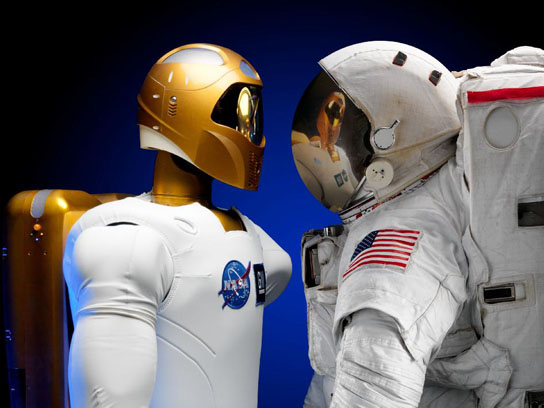
Robonaut 2, a dexterous, humanoid astronaut helper, will fly to the International Space Station aboard space shuttle Discovery on the STS-133 mission. Although it will initially only participate in operational tests, upgrades could eventually allow the robot to realize its true purpose — helping spacewalking astronauts with tasks outside the space station. Credit: NASA/JSC Robert Markowitz
A joint effort between NASA and General Motors to improve robotic technology and capabilities for future space exploration platforms has led to Robonaut 2, NASA’s first dexterous humanoid robot. Robonaut 2 was built to work on space stations, assisting astronauts with dangerous or repetitive jobs.
Robonaut 2, NASA’s first dexterous humanoid robot, has successfully hitched a ride to the International Space Station. Built for the specific purpose of working on the space station, its robotic hands work like human hands with the ability to use human tools to assist astronauts with tasks that are simple, repetitive or potentially dangerous. The technology development demonstration will serve as a springboard to help explore and evolve new robotic capabilities in space and on Earth. Robonaut is a joint project of NASA and General Motors (GM) to improve robotic technology and capabilities for future space exploration platforms, along with advanced vehicle safety systems and manufacturing plants. GM expects Robonaut to validate manufacturing technologies that will improve the health and safety of GM team members throughout the world.
In a recent interview with Nic Radford, Robonaut deputy project manager from NASA’s Johnson Space Center, he shared, “This is one of the first payloads ever on the space station that can actually impart forces in its environment.” Radford added that an ultra-sensitive, built-in safety system can automatically power down Robonaut if it makes unexpected contact with astronauts or equipment on the station. How many ways this technology can be used is yet to be defined, though many people have envisioned interacting with robots their whole lives – even the Jetsons and the Robinsons “lost in space” had a robotic humanoid. “Our whole lab has this sense of ushering in this new paradigm and we are really excited to be in the front of that,” Radford said.
During the interview, Radford talks about Robonaut shaking hands with Expedition 30 Commander Dan Burbank, as well as what the future holds for the robot aboard the International Space Station. With human-like hands and arms, Robonaut is able to use the same tools station crew members use. This technology could potentially change the way we explore our solar system and how the world manages manufacturing and other processes. You can watch Robonaut working the task board in this additional short video, demonstrating its dexterity, vision system, tactile feedback sensors and remote control capabilities on the station. For more information, visit the Robonaut main website.









Be the first to comment on "Robonaut 2: A Robotic Space Station Crew Member"